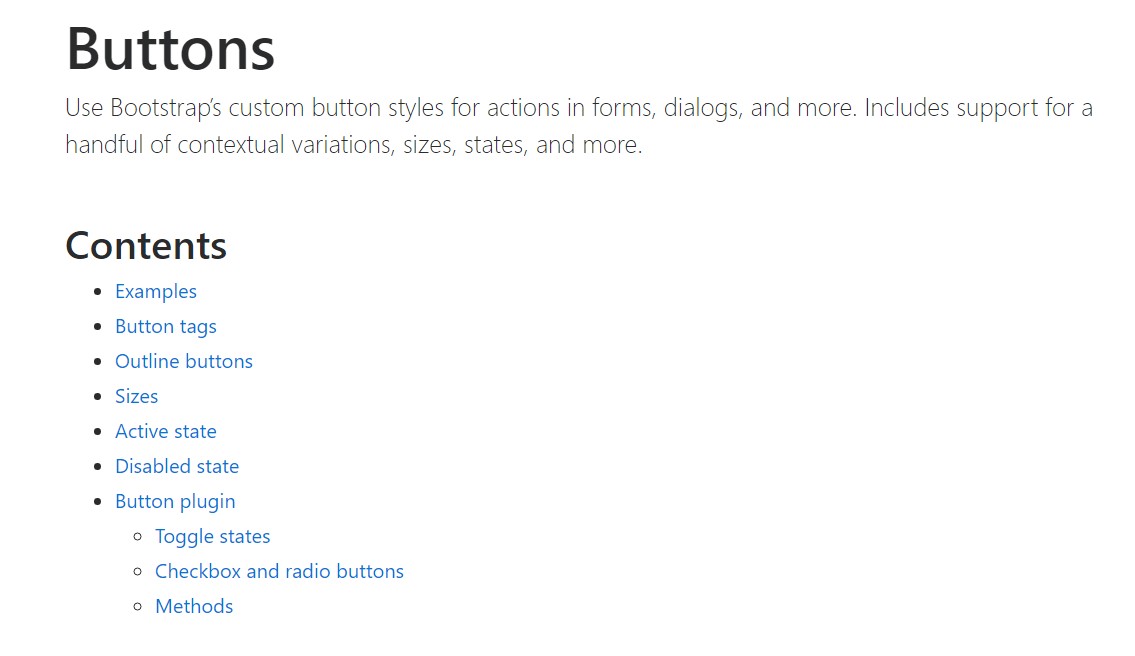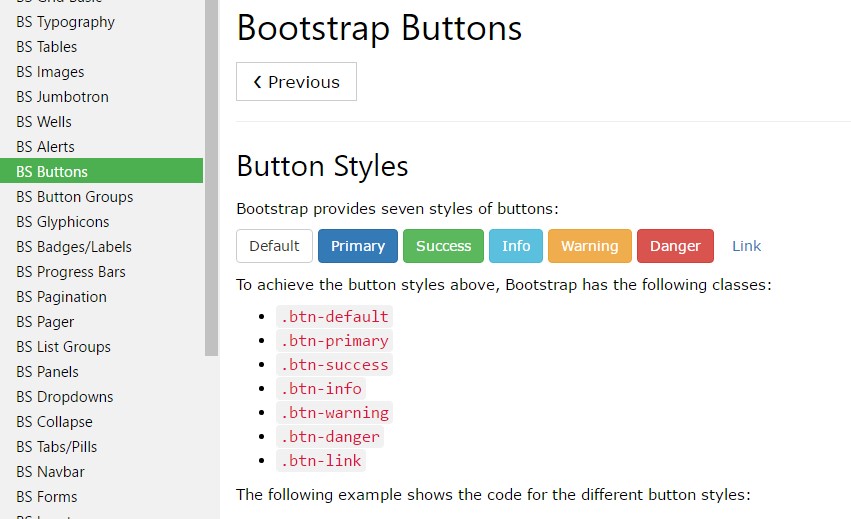Bootstrap Buttons Group
Overview
The button features together with the links wrapped within them are perhaps some of the most very important elements making it possible for the users to interact with the web pages and take various actions and move from one webpage to another. Specifically currently in the mobile first world when about half of the webpages are being observed from small-sized touch screen devices the large comfortable rectangle zones on display very simple to find with your eyes and touch with your finger are even more necessary than ever. That's reasons why the updated Bootstrap 4 framework advanced providing even more convenient experience giving up the extra small button size and providing some more free space around the button's subtitles to get them more easy and legible to use. A small touch bring in a lot to the friendlier looks of the brand new Bootstrap Button Radio are at the same time just a bit more rounded corners which together with the more free space around helping to make the buttons a whole lot more pleasing for the eye.
The semantic classes of Bootstrap Buttons Toggle
In this version that have the identical variety of very easy and amazing to use semantic styles providing the feature to relay definition to the buttons we use with simply just providing a single class.
The semantic classes are the same in number just as in the latest version but with several upgrades-- the hardly ever used default Bootstrap Button On normally having no meaning has been dismissed in order to get changed by much more intuitive and subtle secondary button designing so now the semantic classes are:
Primary .btn-primary - painted in soft blue;
Info .btn-info - a little bit lighter and friendlier blue;
Success .btn-success the good old green;
Warning .btn-warning colored in orange;
Danger .btn-danger which comes to be red;
And Link .btn-link which in turn comes to design the button as the default link element;
Just ensure you first provide the main .btn class before using them.

<button type="button" class="btn btn-primary">Primary</button>
<button type="button" class="btn btn-secondary">Secondary</button>
<button type="button" class="btn btn-success">Success</button>
<button type="button" class="btn btn-info">Info</button>
<button type="button" class="btn btn-warning">Warning</button>
<button type="button" class="btn btn-danger">Danger</button>
<button type="button" class="btn btn-link">Link</button>Tags of the buttons
While applying button classes on <a> components which are used to cause in-page functionality (like collapsing content), instead linking to new webpages or parts within the existing page, these hyperlinks should be given a role="button" to appropriately convey their function to assistive technologies such as screen viewers.

<a class="btn btn-primary" href="#" role="button">Link</a>
<button class="btn btn-primary" type="submit">Button</button>
<input class="btn btn-primary" type="button" value="Input">
<input class="btn btn-primary" type="submit" value="Submit">
<input class="btn btn-primary" type="reset" value="Reset">These are however the fifty percent of the possible visual aspects you can enhance your buttons in Bootstrap 4 due to the fact that the updated version of the framework additionally gives us a new subtle and beautiful way to design our buttons keeping the semantic we already have-- the outline mechanism.
The outline procedure
The solid background without border gets substituted by an outline using some message with the related color option. Refining the classes is totally very easy-- simply just add outline before selecting the right semantics such as:
Outlined Primary button comes to be .btn-outline-primary
Outlined Second - .btn-outline-secondary and so on.
Very important factor to note here is there really is no such thing as outlined hyperlink button in such manner the outlined buttons are really six, not seven .
Take the place of the default modifier classes with the .btn-outline-* ones to remove all background pics and color tones on any kind of button.

<button type="button" class="btn btn-outline-primary">Primary</button>
<button type="button" class="btn btn-outline-secondary">Secondary</button>
<button type="button" class="btn btn-outline-success">Success</button>
<button type="button" class="btn btn-outline-info">Info</button>
<button type="button" class="btn btn-outline-warning">Warning</button>
<button type="button" class="btn btn-outline-danger">Danger</button>Extra text
The semantic button classes and outlined appearances are really great it is important to remember some of the page's visitors won't actually be able to see them so if you do have some a bit more special meaning you would like to add to your buttons-- make sure along with the visual means you also add a few words describing this to the screen readers hiding them from the page with the . sr-only class so actually anybody could get the impression you desire.
Buttons proportions
As we claimed earlier the updated version of the framework angles for legibility and simplicity so when it comes to button proportions along with the default button scale that needs no additional class to get appointed we also have the large .btn-lg as well as small .btn-sm sizes yet no extra small option due to the fact that these are far too hard to aim with your finger-- the .btn-xs from the previous version has been cast off. However we still have the practical block level button element .btn-block When you need it, spanning the whole width of the element it has been placed within which combined with the large size comes to be the perfect call to action.

<button type="button" class="btn btn-primary btn-lg">Large button</button>
<button type="button" class="btn btn-secondary btn-lg">Large button</button>
<button type="button" class="btn btn-primary btn-sm">Small button</button>
<button type="button" class="btn btn-secondary btn-sm">Small button</button>Create block level buttons-- those that span the full width of a parent-- by adding .btn-block.

<button type="button" class="btn btn-primary btn-lg btn-block">Block level button</button>
<button type="button" class="btn btn-secondary btn-lg btn-block">Block level button</button>Active setting
Buttons will appear pressed (with a darker background, darker border, and inset shadow) when active.

<a href="#" class="btn btn-primary btn-lg active" role="button" aria-pressed="true">Primary link</a>
<a href="#" class="btn btn-secondary btn-lg active" role="button" aria-pressed="true">Link</a>Disabled mechanism
Make buttons look inactive by putting in the disabled boolean attribute to any sort of <button> element.

<button type="button" class="btn btn-lg btn-primary" disabled>Primary button</button>
<button type="button" class="btn btn-secondary btn-lg" disabled>Button</button>Disabled buttons operating the <a> element behave a bit different:
- <a>-s do not support the disabled feature, in this degree you have to provide the .disabled class to get it visually appear disabled.
- A number of future-friendly styles are involved to turn off every one of pointer-events on anchor buttons. In internet browsers which support that property, you won't notice the disabled arrow in any way.
- Disabled buttons should provide the aria-disabled="true" attribute to signify the state of the component to assistive technologies.

<a href="#" class="btn btn-primary btn-lg disabled" role="button" aria-disabled="true">Primary link</a>
<a href="#" class="btn btn-secondary btn-lg disabled" role="button" aria-disabled="true">Link</a>Link capability caveat
The .disabled class puts into action pointer-events: none to try to disable the web link useful functionality of <a>-s, but that CSS property is not still standard. In addition, even in web browsers that do support pointer-events: none, keyboard navigation stays uninfluenced, meaning that sighted key board users and users of assistive technological innovations will still be capable to activate these urls. So to be safe, add a tabindex="-1" attribute on these hyperlinks ( to keep them from receiving key-board focus) and use custom JavaScript to disable their functionality.
Toggle function
Add in data-toggle=" button" to toggle a button's active form. On the occasion that you're pre-toggling a button, you need to by hand add the active class and aria-pressed=" true" to the
<button>
.

<button type="button" class="btn btn-primary" data-toggle="button" aria-pressed="false" autocomplete="off">
Single toggle
</button>More buttons: checkbox plus radio
Bootstrap's .button styles can possibly be applied to various other elements, for example <label>- s, to generate checkbox or radio style button toggling. Add data-toggle=" buttons" to .btn-group having those changed buttons to allow toggling in their various styles. The checked condition for all these buttons is only updated by using click event on the button. If you put into action an additional approach to update the input-- e.g., with <input type="reset"> or simply by manually applying the input's examined property-- you'll have to toggle .active on the <label> manually.
Note that pre-checked buttons demand you to manually provide the .active class to the input's <label>.

<div class="btn-group" data-toggle="buttons">
<label class="btn btn-primary active">
<input type="checkbox" checked autocomplete="off"> Checkbox 1 (pre-checked)
</label>
<label class="btn btn-primary">
<input type="checkbox" autocomplete="off"> Checkbox 2
</label>
<label class="btn btn-primary">
<input type="checkbox" autocomplete="off"> Checkbox 3
</label>
</div>
<div class="btn-group" data-toggle="buttons">
<label class="btn btn-primary active">
<input type="radio" name="options" id="option1" autocomplete="off" checked> Radio 1 (preselected)
</label>
<label class="btn btn-primary">
<input type="radio" name="options" id="option2" autocomplete="off"> Radio 2
</label>
<label class="btn btn-primary">
<input type="radio" name="options" id="option3" autocomplete="off"> Radio 3
</label>
</div>Approaches
$().button('toggle') - toggles push condition. Brings the button the looks that it has been turned on.
Final thoughts
So probably in the new version of the most well-known mobile first framework the buttons evolved directing to eventually become even more sharp, more easy and friendly to work with on small display and so much more powerful in expressive methods with the new outlined form. Now all they need is to be placed in your next great page.
Take a look at a number of youtube video information about Bootstrap buttons
Connected topics:
Bootstrap buttons approved records

W3schools:Bootstrap buttons tutorial

Bootstrap Toggle button
